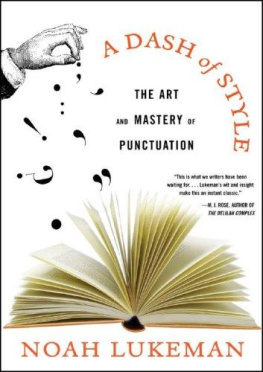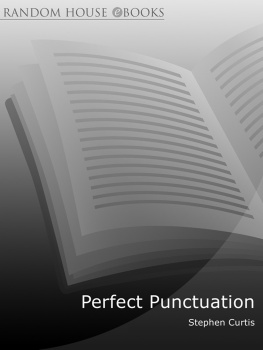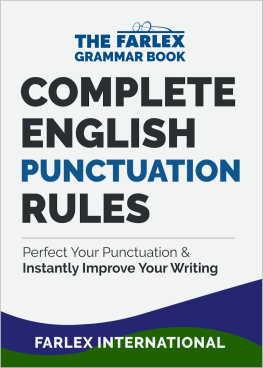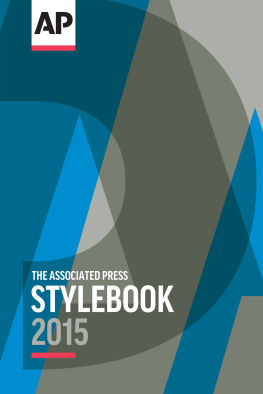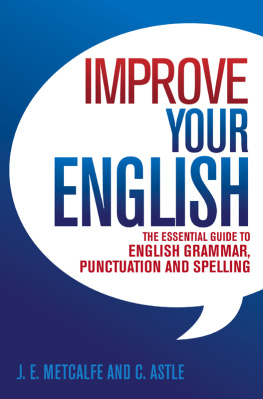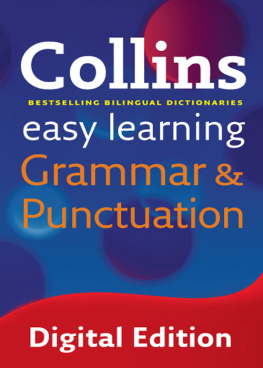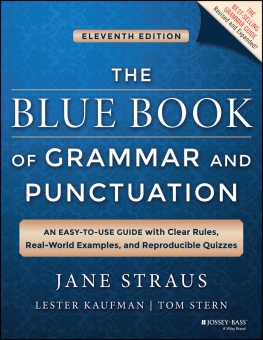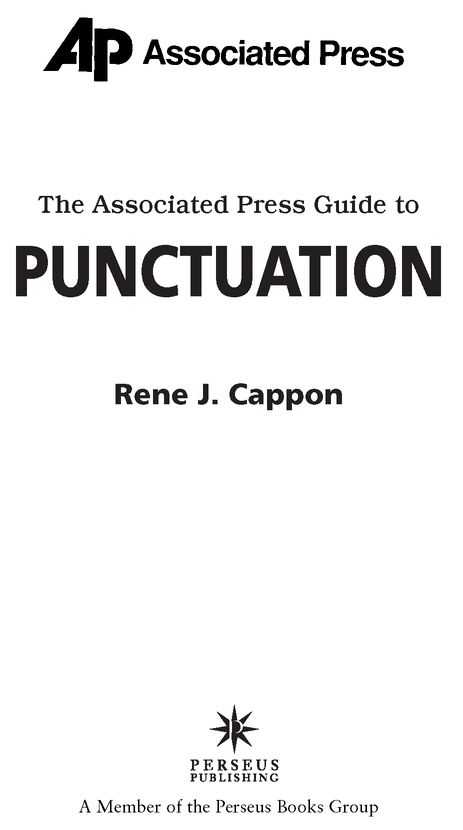Table of Contents
ALSO BY
THE ASSOCIATED PRESS
The Associated Press
Guide to Internet Research
and Reporting
The Associated Press
Stylebook and Briefing
on Media Law
Chapter 1
INTRODUCTION
Punctuation in skilled hands is a remarkably subtle system of signals, signs, symbols and winks that keep readers on the smoothest road.
Too subtle, perhaps: Has any critic or reviewer ever praised an author for being a master of punctuation, a virtuoso of commas? Has anyone ever won a Pulitzer, much less a Nobel, for elegant distinctions between dash and colon, semicolon and comma?
In the word business, punctuation is considered a given (it isnt, and actually takes thought). So perhaps its true, as has been long rumored, that some respected authors leave punctuation to such inferior beings as editors and proofreaders.
What does punctuation actually do? Thats what this little book is about, but, in general, punctuation links or separates sentences and their elements, avoids ambiguities, clarifies meanings and sometimes refines them.
As a small example, the lowly hyphen differentiates a small business association (a small group) from a small-business association (a group composed of small businesses). The hyphen shows what words need to be read as one.
More complicated, commas spell the difference between essential clauses (vital to the meaning) from nonessential clauses, adding peripheral description or information.
Necessary as it is (try writing a passage without punctuation), word people hardly ever fly into a passion on the subject, as they would over points of grammar and word choice.
Thats not because punctuation resembles the peaceable kingdom where everything is settled. As Theodore Bernstein has said in The Careful Writer:
About the only thing writers and editors agree on... is that a period is placed at the end of a declarative sentence... and that a question mark is placed at the end of a sentence that genuinely asks a question.
Oddly, the disagreements have produced little turbulence. One of the few disputes that resembled a controversy involved the question of whether a comma should go before the and in the final term of a series: Tom, Dick, and Harry. The great majority decided to forgo the comma. A minority kept it, and both went their own way.
The fact is that publications, usually ensconced behind their own stylebooks, do their own thing without polemics or efforts at conversion. Styles simply differ (and readers, I suspect, are none the wiser).
Some authorial eccentricities, however, could hardly escape attention. Gertrude Stein generally avoided punctuation lest it distract from her words. (Most readers would have found her words distracting enough.)
James Joyce had no use for quotation markshe used dashes insteadand the entire long soliloquy of Molly Bloom at the end of Ulysses is innocent of punctuation, compounding confusion among readers minds.
George Bernard Shaw, a writer of great force and clarity, took a dislike to the apostrophe. He spelled contractions dont, couldnt, wont, doesnt, as it appears in all his printed works. And the poet E.E. Cummings found capital letters offensive and printed everything in lowercase.
For many millenniums, language meant speech and speech only. Not until some Mesopotamian spoilsports devised a workable alphabet did writing make the scene, albeit in cuneiform and solely for commercial use or to lavish fulsome praise on kings and kinglets.
It took several more millenniums before writing spread from a handful of clerics and learned elites into a common blessing of selected cultures.
But written words, however sophisticated, never threatened the supremacy of speech as the arbiter of language change. That still holds true.
Take the adverb hopefully, if you can bear it. Language critics and commentators condemned it vociferously, but it became common in speechand is now common in writing, too. Its similar to many vainly proscribed words. Snuck, for sneak, is among the latest.
Besides its impregnable position as the conductor of language usage, speech held another advantage over writing, and that was clarity. Hearers could seldom misunderstand the speaker, for speech has a prodigious non-verbal arsenal: pitch, pause, stress, intonation, facial expression, gesture, body language.
It was to make up for the loss of speech accouterments that punctuation gradually developed. The idea goes back hundreds of years, furthered powerfully by the invention of movable type and the early printers of the 15th century. The Gutenberg Bible already had periods, commas and colons.
Like most style matters, punctuation changed over the years. In earlier days, it reflected spoken delivery, carefully marking places where speakers and readers had to take a breath. The so-called breath comma, an annoyance to the fastidious, survived well into the era when nobody read aloud anymore.
Punctuation today is oriented to the grammatical rather than the rhetorical, and it conforms to the modern principle that less is more. We punctuate conservatively, avoid all surplus.
By our standards, the literary lights of the 17th and 18th centuries indulged in lavish overpunctuation.
Commas, colons, semicolons, even dashes pop up wildly in spots where we would never place them. Commas habitually appear before that clauses that we leave alone. Two examples from Samuel Johnson: It is not improbably, that Shakespeare put... and The only passage, by which it could be entered, was a cavern...
Somebody took the trouble to count overwrought punctuation in a letter by Lord Chesterfield, valued for his style. In 50 sentences, he counted 45 semicolons, 8 colons, and no fewer than 193 commas.
Thats overdone by our lights, to put it mildly. But we should remember also that the age of overpunctuation was also the age of Swift, Pope, Dryden, Addison, Steele, Boswell, Jonson and other literary giants.
Rene J. Cappon
The Associated Press
Chapter 2
THE AMPERSAND
Not many people know the word, but everybody knows the sign (&) that stands for and.
The ampersand apparently was invented in the 17th century, and was once widely used as a space-saver.
Nowadays, it should be confined to names that formally contain it: AT&T, Newport News Shipping & Dry Dock Co.
The ampersand ranks first among punctuation marks by virtue of the alphabet, but its significance is last.
Chapter 3
THE APOSTROPHE
The apostrophe is an alphabetical neighbor to the ampersand, but is far more versatile. Anything but a slug would be.
People may laugh at the grimly limited ampersand, but nobody laughs at the apostrophe. One of its main jobs is to ride herd on possessives, which is serious business, indeed.
So serious, in fact, that the Oxford Companion to English Literature observes glumly: There never was a golden age in which the rules for the possessive apostrophe were clear-cut and known, understood, and followed by most educated people.
I cannot hope to reconstruct a golden age that never existed, but I can offer some basic guidelines to contemporary usage. Granted, they arent universally acceptedfew elements of punctuation arebut Ill happily sidestep grammarian disputes.



